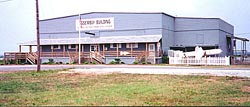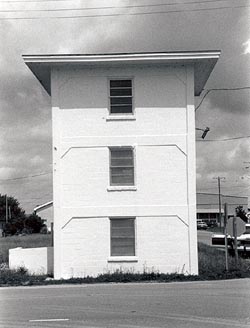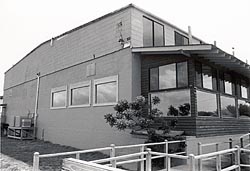
At the end of World War II the Navy established the US Naval Ordnance Test Facilities at Topsail Island, North Carolina, for Operation Bumblebee, a top-secret, experimental project to develop and test ramjet missiles, which advanced the Nation's jet aircraft and missile programs. So successful were the tests conducted at the Topsail Island site that the ramjet proved its value, opened the way for the advance of supersonic jet aircraft design and brought the United States to the threshold of modern space technology with the Talos, Terrier, Tartar and Sea Sparrow missiles aboard naval vessels. Named after a bumblebee, which although aerodynamically unable to fly, does not know this and flies anyway, this operation lead to the maturing of supersonic aircraft and shipboard missile design in the mid-20th century.
Topsail Island was the third of three widespread test sites established along the Atlantic seaboard in the closing years of World War II, and the first permanent ground for missile testing. The Topsail Island site, placed in operation in March 1947, incorporated rigid structures that were designed and built for specific uses related to the assembly, firing, monitoring and perfecting of experimental ramjet missiles. The buildings associated with this testing, the Assembly Building, Facility Control Tower and Observation Tower No. 2 possess exceptional importance because they are the only aboveground resources remaining at these three sites where the Nation's burgeoning ramjet missile program grew from experimentation to maturity. The Assembly Building is a one-and-a-half-story masonry building and the Control Tower is a three-story reinforced concrete building. Observation Tower #2 is an unaltered example of the seven instrument towers erected on Topsail Island.

The first explanation of the theory behind the ramjet engine was made in 1908 by a French engineer, Rene Lorin, who speculated that exhausts from standard internal combustion engine, if directed into diverging nozzles, produced jets that would propel the vehicle. During World War I, Lorin brought his theories of the ramjets to the attention of the French government, suggesting that it might be used to defeat the Germans. He was not taken seriously at the time, and little attention was given to refining ramjets at the time. The incentive came in World War II with the impact of Germany's V-2 rocket assaults on France and England in 1944. Following the war, the research and development of high-altitude warfare became a vital and competitive affair on an international scale. In the United States, the first test site for ramjet missiles was at Island Beach, New Jersey, managed by the U.S. Navy in association with the John Hopkins University Applied Physics Laboratory and the Kellex Corporation. The second installation was activated at Fort Miles, Delaware, in early 1946. However, by April 1946, a joint report by the Navy and its partners identified Topsail Island as the most suitable location for a permanent test site.

Naval and Marine personnel, numbering 500 men, and led by Lieutenant Commander Tad Stanwick, arrived at the site by mid-1946 to begin installation of the facilities needed for the testing. Research, development and testing of the missile components were handled by the Applied Physics Laboratory at Silver Spring, Maryland, and the two-stage rockets, consisting of a solid booster to launch the missile and a ramjet engine to bring it up to supersonic speed, were made at Cumberland, Maryland.
During the next 18 months, an estimated 200 experimental rockets, each measuring six inches in diameter and between three and 13 feet in length, were fabricated at the Assembly Building, dispatched to the launch site, and fired along a northeasterly angular deflection of 15 degrees to the shoreline for a maximum clear distance of 40 miles. Despite the initial success of the US Naval Ordnance Testing facility at Topsail Island over its 18-month span, its location did not fulfill completely the needs of a permanent base because weather conditions and increased sea traffic interfered with testing, and the facility was abandoned and its equipment moved to other sites.
Visit the National Park Service Travel American Aviation to learn more about Aviation related Historic Sites.
Last updated: August 29, 2017
